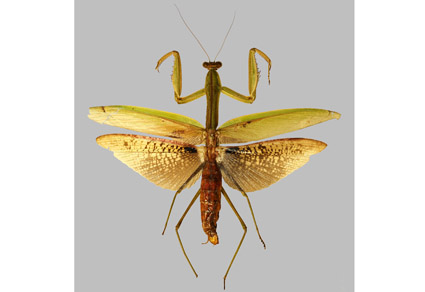Abstract
This is a first description of a complete bilateral gynandromorph in Mantodea, as well as the first description of a complete gynandromorph of Tenodera sinensis Saussure. This specimen, collected from Kasai-Rinkai Park in Tokyo, Japan, exhibits predominantly male characteristics on the left side of its body and female characteristics on the right side. The left lateral has some features of male, and the notable differences between right and left lateral were found on the antennae, the ocelli, the compound eyes, the forewings and abdominal sternites VII to IX.
References
- Agudelo, A.A. (2014) Intersexuality in the holotype of Photina gracilis (Mantodea: Mantidae: Photininae) and its taxonomic implications. Sociedade Brasileira de Zoologia, 31 (4), 408–411. http://dx.doi.org/10.1590/S1984-46702014000400014
- Ando, Y. (2021) What do we learn from praying mantises? Hokuryukan, Tokyo, 213 pp. [in Japanese with English title]
- Battiston, R., Piciau, L., Fontana, P. & Marshall, J. (2010) Mantids of the Euro-Mediterranean Area. World Biodiversity Association, Verona, 239 pp.
- Béthoux, O. (2010) Alteration of sex-related developmental modules: A case of "feminized" male wing morphology in Creobroter gemmatus (Mantodea: Hymenopodidae). European Journal of Entomology, 107, 133–135. https://doi.org/10.14411/eje.2010.018
- Brannoch, S.K., Wieland, F., Rivera, J., Klass, K.-D., Béthoux, O. & Svenson, G.J. (2017) Manual of praying mantis morphology, nomenclature, and practices (Insecta, Mantodea). Zookeys, 696, 1–100. https://doi.org/10.3897/zookeys.696.12542
- Carle, T., Yamawaki, Y., Watanabe, H. & Yokohari, F. (2014) Antennal Development in the Praying Mantis (Tenodera aridifolia) Highlights Multitudinous Processes in Hemimetabolous Insect Species. PLoS ONE, 9 (6), e98324. https://doi.org/10.1371/journal.pone.0098324
- Ehrmann, R. & Borer, M. (2015) Mantodea (Insecta) of Nepal: an annotated checklist. In: Hartmann, Weipert (Eds.) Biodiversität und Naturausstattung im Himalaya, Band V. Naturkundemuseum, Erfurt, pp. 227–274.
- Fox, H. (1939) The Egg Content and Nymphal Production and Emergence in Oothecae of Two Introduced Species of Asiatic Mantids (Orthoptera: Mantidae). Annals of the Entomological Society of America, 32, 549–560. https://doi.org/10.1093/aesa/32.3.549
- Fusco, G. & Minelli, A. (2023) Descriptive versus causal morphology: gynandromorphism and intersexuality. Theory in Biosciences, 142, 1–11. https://doi.org/10.1007/s12064-023-00385-1
- Hurd, L.E. (1999) Ecology of praying mantids. In: Prete, F.R., Wells, H., Wells, P.H. & Hurd, L.E. (Eds.), The Praying Mantids. Johns Hopkins University Press, Baltimore, MD, pp. 43–60.
- Jensen, D., Svenson, G.J., Song, H. & Whiting, M.F. (2009) Phylogeny and evolution of male genitalia within the praying mantis genus Tenodera (Mantodea: Mantidae). Invertebrate Systematics, 23, 409–421. https://doi.org/10.1071/IS09004
- Klass, K.D. (1997) The external male genitalia and the phylogeny of Blattaria and Mantodea. Bonner Zoologische Monographien, 42, 1–341.
- Laurent, P. (1898) A species of Orthoptera. Entomological News, 9, 144–145.
- Lombardo, F. & Umbriaco, R. (2011) Taxonomic re-evaluation of Parastagmatoptera abnormis Beier, 1963 (Dictyoptera, Mantidae: Stagmatopterinae): An unusual case of "parasite-induced" synonymy. Zootaxa, 2735, 31–34. https://doi.org/10.11646/zootaxa.2735.1.4
- Nagashima, Y. (1988) A note on the Orthopteroid insects (Blattodea, Mantodea, Orthoptera, Phasmida) of Sado Island, Niigata Prefecture. Research reports of Niigata Seiryo Women's College, (18), 17–26. [in Japanese with English title]
- Nakamine, H. (2016) Mantodea. In: Orthopterological Society of Japan (Ed.), The Standard of Polyneoptera in Japan. Gakken Plus, Tokyo, pp. 198–205. [in Japanese with English title]
- Narita, S., Pereira, R.A.S., Kjellberg, F. & Kageyama, D. (2010) Gynandromorphs and intersexes: potential to understand the mechanism of sex determination in arthropods. Terrestrial Arthropod Reviews, 3, 63–96. https://doi.org/10.1163/187498310X496190
- Okada, M. (2001) Kontyû-hantâ Kamakiri no subete [All of mantis insect hunters]. Tonbo-shuppan, Osaka, 63 pp. [in Japanese]
- Oshima, K., Nagano, H., Taguchi, A. & Tsuchiya, K. (2022) Records of Orthoptera, Mantodea and Phasmatodea on Kii-oshima Island, Wakayama Pref., Japan. Gekkan-Mushi, A Monthly Journal of Entomology, (619), 8–17. [in Japanese with English title]
- Oshima, K., Kaneko, N. & Nagano, H. (2023) New records of Tenodera sinensis Saussure, 1871 (Mantodea: Mantidae) from Ani-jima Island and Ototo-jima Island, the Ogasawara Islands, Tokyo, Japan. Japanese Journal of Entomology, New Series, 26 (2), 124–127. [in Japanese with English title]
- Patel, S. & Singh, R. (2016) Updated Checklist and Distribution of Mantidae (Mantodea: Insecta) of the World. International Journal of Research Studies in Zoology, 2 (4), 17–54. https://doi.org/10.20431/2454-941X.0204003
- Pickard, S.C, Bertsch, D.J., Garrec, Z.L., Ritzmann, R.E., Quinn, R.D. & Szczecinski, N.S. (2021) Internal state effects on behavioral shifts in freely behaving praying mantises (Tenodera sinensis). PLOS Computational Biology, 17 (12), e1009618. https://doi.org/10.1371/journal.pcbi.1009618
- Roy, R. (2003) A propos de deux males parasites de Prohierodula Bolivar, 1908 (Dictyoptera, Mantidae). Bulletin de la Société entomologique de France, 108 (2), 181–183. [in French] https://doi.org/10.3406/bsef.2003.16952
- Schwarz, C.J. & Roy, R. (2019) The systematic of Mantodea revisited: an updated classification incorporating multiple data sources (Insecta: Dictyoptera). Annales de la Société entomologique de France (Nouvelle Série), 55 (2), 101–196. [in English with French title and abstract] https://doi.org/10.1080/00379271.2018.1556567
- Toshima, H. & Yakuo, S. (1993) Records of insects from Islands in Kagawa Prefecture (I). Kagawa Seibutsu, (20), 21–37. [in Japanese with English title]
- Yager, D.D. & Svenson, G.J. (2008) Patterns of praying mantis auditory system evolution based on morphological, molecular, neurophysiological, and behavioural data. Biological Journal of the Linnean Society, 94 (3), 541–568. https://doi.org/10.1111/j.1095-8312.2008.00996.x


